 |
Tony Prentice
 |
After seeing the prototype of Geoff McBroom’s rogallo at the Southdown Gliding Club meeting in 1972 and its using of aluminium tube for the frame. I decided to build No3 using aluminium tubing. The sail was cut directly from an army surplus cargo parachute but it was too porous. The sail did have battens in the trailing edge to overcome the stretch of the material but with no top rigging to maintain the reflex the glider was divergent. The film shows the glider being flown on the Southdown’s and on the Isle of Wight and was the first to be flown there. Pete Scott who lives on the island showed me around and many of the sites we found are still in use for hang gliding or paragliding. When flying off Wrotham Hill a storm front came in with rain and strong squalls. The rain ‘proofed’ the material and with the increased wind speed I found myself at about 300ft above the hill. I managed to keep control but was pleased to get back on the ground in one piece.
It was time to design a more stable and efficient wing.
If you look carefully at the nose of the wing you will see it is truncated. The keel has a "T" piece and the wing tubes are hinged at the end of the "T" bar. This reduced the wing tube length but maintained the span. The "T" had a foam insert which made it a thicker leading edge section and acted as cushioning if the nose went in.
Filmed in 1973
Photo and Video from Tony Prentice
© Copyright Tony Prentice All Rights Reserved
All the material on this site is subject to copyright Much of this material may only be reproduced with the written permission of the copyright holder |